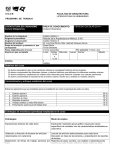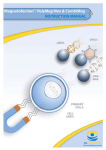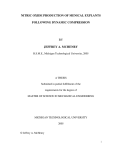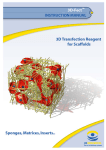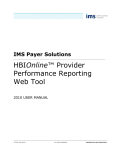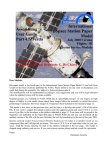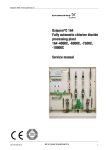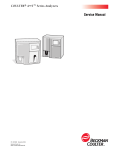Download Magnetofection
Transcript
OZ Biosciences / Protocol Magnetofection / www.ozbiosciences.com / -0- Magnetofection Instruction Manual Magnetofection is a novel, simple and highly efficient in vitro and in vivo transfection method * List of Magnetofection™ Kits 1 2 Catalog Number Description Volume (µL) Size (number of transfection / µg of DNA) Number of transfections / 96 well plates PN-30100 PN-30200 PN-31000 PolyMag II PolyMag II PolyMag II 100 200 1000 100 200 1000 1000 2000 10000 CM-20100 CM-20200 CM-21000 CombiMag CombiMag CombiMag 100 200 1000 100 200 1000 1000 2000 10000 KM-30200 KC 30296 Magnetofection Selection Kit 1 Magnetofection Starting Kit 2 200 (2 X 100) 200 (2 X 100) 200 200 2000 2000 MF-10096 Magnetic Plate N/A N/A N/A Contains 1 vial of each reagent (PolyMag and CombiMag) Contains 1 vial of each reagent (PolyMag and CombiMag) plus a Magnetic Plate Use the content of the table above to determine the appropriate catalog number for your needs. You can order these products by contacting us. For all other supplementary information, do not hesitate to contact our dedicated technical support. OZ BIOSCIENCES Parc Scientifique et Technologique de Luminy BP13 13273 Marseille Cedex 9, France Tel: +33 (0) 4.91.82.81.72 Fax: +33 (0) 4.91.82.81.70 E-mail: [email protected] Site Internet: www.ozbiosciences.com * Patent Pending OZ Biosciences / Protocol Magnetofection / www.ozbiosciences.com / -1- 1. Technology 1.1. Description Congratulations on your purchase of the Magnetofection reagent! Magnetofection™ is a novel, simple and highly efficient method to transfect cells in culture and in vivo. It exploits magnetic force exerted upon gene vectors associated with magnetic particles to drive the vectors towards, possibly even into, the target cells. In this manner, the complete applied vector dose gets concentrated on the cells within a few minutes so that 100% of the cells get in contact with a significant vector dose. This has several important consequences: 1. Greatly improved transfection rates in terms of percentage of cells transfected compared to standard transfections. 2. Up to several thousand folds increased levels of transgene expression compared to standard transfections. 3. High transfection rates and transgene expression levels are achievable with extremely low vector doses, which allow saving expensive transfection reagents. 4. Extremely short process time in comparison to standard procedures. A few minutes of incubation of cells with gene vectors are sufficient to generate high transfection efficiency. Based upon a validated and recognized magnetic drug targeting technology this innovative method is: • Efficient • Simple & rapid • Multipurpose (for all types of nucleic acid and viral & non-viral vectors) • Universal (primary cells and cell lines) • Non toxic & economical 1.2. Available Kits OZ Biosciences offers two types of ready-to-use Magnetofection reagents. 1. PolyMag is a universally applicable magnetic particle preparation for high efficiency nucleic acid delivery. Nucleic acids to be transfected and the magnetic particles are mixed in a one-step procedure PolyMag has been used successfully with plasmid DNA, phosphorothioate antisense oligonucleotides and siRNAs. 2. CombiMag is a magnetic particle preparation designed to be combined with any commercially available transfection reagent such as cationic polymers and lipids and can be associated with viruses. CombiMag has been used successfully with plasmid DNA, antisense oligonucleotides, siRNAs adenovirus and retrovirus 1.3. Kit Contents Kit contents varies according to their size • One tube containing 100 µL of particle suspension good for 100 transfections with 1 µg of DNA • One tube containing 200 µL of particle suspension good for 200 transfections with 1 µg of DNA • 1 tube containing 1000 µL of particle suspension good for 1000 transfections with 1 µg of DNA OZ Biosciences / Protocol Magnetofection / www.ozbiosciences.com / -2- Stability and Storage Storage +4ºC. Upon receipt and for long-term use, store all reagent tubes in the fridge. Magnetofection kits are stable for at least one year at the recommended storage temperature. • • DO NOT FREEZE THE MAGNETIC NANOPARTICLES! DO NOT ADD ANYTHING TO THE STOCK SOLUTION OF MAGNETIC NANOPARTICLES! Shipping condition Room Temperature 2. Applications 2.1. Nucleic Acids Dose Response and Transfection Kinetics Save Times 200 param agnetic vehicle plus m agnetic field 150 param agnetic vehicle no m agnetic field 100 standard gene transfer 50 0 0 0.05 0.1 0.15 response (expression lev response (expression lev Save Materials 300 200 100 0 0 50 dose (µg DNA) DNA dose response profile. NIH-3T3 cells were transfected with a commercial transfection reagent L +/- CombiMag with and without the magnetic field for 15 min. Luciferase expression was assayed after 24 hours. 100 150 200 250 process time (min) Transfection kinetics NIH-3T3 cells were incubated with a commercial transfection reagent G ± CombiMag with and without positioning on the magnetic plate for the indicated time spans. Luciferase expression was assayed after 24 hours. 2.2. Nucleic Acids Types and Vectors The CombiMag reagent can be combined with any nucleic acid, any cationic polymer-based and lipidbased transfection reagent and also with virus (adenovirus or retrovirus). Nucleic Acid or Virus Type DNA (plasmid) Antisense Oligonucleotides siRNA Adenovirus Retrovirus PolyMag √ √ √ n.d. n.d. CombiMag √ √ √ √ √ OZ Biosciences / Protocol Magnetofection / www.ozbiosciences.com / -3- 2.3. Cell Types Magnetofection is generally applicable on numerous cell types. This technology has been tested successfully on a variety of immortalized cell lines as well as primary cells (see table below). If a particular cell type or cell line is not listed below, this does not imply that Magnetofection is not going to work. OZ Biosciences is going to maintain an updated list of cells successfully tested that is available on the website: www.ozbiosciences.com. For the cells listed, some reagents have not been tested so far, as indicated by ″n.d.″ (not determined). Primary Cells Standard Transfection Magnetofection Standard Transfection Magnetofection Confluent Primary Human Keratinocytes Transfected with a commercial reagent L or PolyMag Reporter Gene: GFP* Primary Human Keratinocytes Transfected with a commercial reagent F +/- CombiMag Reporter Gene: GFP* Primary Chondrocytes / Pig Transfected with a commercial reagent F +/- CombiMag Reporter Gene: β-galactosidase* Cell Lines CT-26 Colon Carcinoma / Mouse Transfected with a commercial reagent D or PolyMag Reporter Gene: GFP* HUVEC-C (Primary) / Human Transfected with a commercial reagent E +/- CombiMag Fluorescent Oligonucleotides ** We are grateful to the laboratories of * Dr. C. Plank (Technical University, Munich) and of ** Dr. F. Kroetz (Ludwig-Maximilians University, Munich) for kindly providing these data. OZ Biosciences / Protocol Magnetofection / www.ozbiosciences.com / -4- Cell Line Cell Type Source PolyMag CombiMag 293, HEK-293, Transformed Embryonic Kidney 293-T, -EBNA 16HBE14o Airway Epithelium Human √ √ Human √ √ 181RDB Pancreatic Cells Human n.d. √2 A549 Non-small cell lung carcinoma Human n.d. √ 1, 2 B16F10 Melanoma Mouse √ √ CHO-K1 Epithelial-like (Ovary) Hamster √ √ COS-1 Fibroblast (Kidney) Green Monkey √ √ COS-7 Fibroblast (Kidney) Green Monkey √ √ CT-26 Colon Carcinoma Mouse √ √ CV-1 Fibroblast-like (Kidney) Monkey √ √ HeLa Cervical Epithelial Carcinoma Human √ √ HepG2 Hepatoma Human √ √ HUVEC Endothelial Cells (primary) Human √ √ K-562 Myelogenous Leukemia Human n.d. √1 L929 Fibrosarcoma Mouse √ √ MCF-7 Breast Adenocarcinoma Human √ √ MDCK Normal -Kidney Canine √ √ NIH3T3 Fibroblasts Mouse √ √ PC-12 Pheochromocytoma (adrenal) Rat √ √ SAOS Osteosarcoma Human n.d. √2 U937 Histiocytic Lymphoma Human n.d. √2 Pig n.d. √ Human Bovine Bovine √ √1 √ n.d. Primary Chondrocytes Pig √ √1 Primary Fibrochondrocytes Pig √ √ Human Mouse Human n.d. √1 √ √ Primary Airway Epithelium Primary Aortic Endothelial Cells (PAEC) Primary Carotid Artery Smooth Muscle Cells Primary Keratinocytes Primary Nasal Airway Epithelium Human n.d. √ 1,2 Mouse 1 Successfully tested in combination with several commercially available transfection reagents (F, L, D, E…) and 2 adenovirus. *, ** For more information see the bibliographic references at the end of this manual. Primary Peripheral Blood Lymphocytes OZ Biosciences / Protocol Magnetofection / www.ozbiosciences.com / -5- 3. Magnetofection Apparatus Apart from suitable magnetic nanoparticles, Magnetofection requires appropriate magnetic fields. A magnetic plate especially designed for Magnetofection is provided to exert these specific magnetic fields. Its special geometry not only produces strong magnetic fields under each well of 96-well plates but is also applicable for other plate formats (T-75 flasks, 60 & 100 mm dishes, 6-, 12- and 24-well plates). In the larger plate formats, the magnetic plate will produce a pattern of higher and lower densities of transfected cells according to the geometry of the magnetic field lines. 4. Example Protocols 4.1. General Considerations The instructions given below represent sample protocols that were applied successfully with a variety of cell lines. Optimal conditions do vary from cell line to cell line and are dependent on the nucleic acid, transfection reagent or virus used. Consequently, the amounts and ratio of the individual components (DNA and reagents) may have to be adjusted to achieve best results. Therefore, we advise you to optimize the various transfection or infection parameters (components concentration, cell number, incubation time…). Several protocol optimizations are available in the Appendix. The following recommendations can be used as guidelines to achieve good transfection with minimal incubation times. 4.2. General Protocol It is recommended to seed or plate the cells the day prior transfection. The suitable cell density will depend on the growth rate and the conditions of the cells. Cells should be 60-90 % confluent at the time of Magnetofection (see the suggested cell number in the table below). For suspension cells, use the specific protocol given below or seed the cells on polylysine-coated plates (0.1 – 2x106 cells/96 – 6 well plates) and use the protocol for adherent cells. Immediately preceding transfection, the medium can be replaced with fresh medium (optionally without serum) if necessary. Cell Number and Transfection Volume Suggested Tissue Culture Dish Cell Number DNA Quantity Transfection Volume (µg) 4 96 well 0.5 – 2 x 10 0.1 – 0.5 200 µL 5 24 well 0.5 – 1 x 10 0.5 - 2 500 µL 12 well 1 – 2 x 10 5 2-4 1 mL 5 6 well 2 – 4 x 10 2-6 2 mL 5 60 mm dish 5 – 10 x 10 6-8 5 mL 90 - 100 mm dish 10 – 20 x 10 5 8 - 12 10 mL T-75 flask 20 – 50 x 10 5 15 - 25 15-20 mL OZ Biosciences / Protocol Magnetofection / www.ozbiosciences.com / -6- The same protocol can be used to produce stably transduced cells except that 48 hours post transfection; cells are transferred to fresh medium containing the appropriate antibiotics for selection. It is important to wait at least 48 hours before exposing the transduced cells to selection media. Vectors are prepared in medium without serum and supplement or in physiological saline because serum may interfere with vector assembly. According to the standard Magnetofection protocol, the serum and supplement-free vector cocktail is added to the cells that are covered with complete medium. Therefore, the addition of the transfection cocktail will result in the dilution of supplements such as serum, antibiotics or other additives of your standard culture medium. Although a medium changes after Magnetofection is not required for most cell types, it may be necessary for cells that are sensitive to serum/supplement concentration. Alternatively, the cells may be kept in serum-free medium during Magnetofection. In this case, a medium change will be required after Magnetofection. 4.3. PolyMag The protocol is as simple as follows: Use 1 µL of PolyMag per µg of DNA. 1) Before each use, vortex the PolyMag material. Add 1 to 10 µL of PolyMag (according to the DNA amount) to a microtube or to a microwell (U-bottom well is preferred to get a better mixing). If required and for doses less than 1 µL in your protocol, predilute PolyMag with deionized water. 2) Dilute 1 to 10 µg of DNA to 200 µL with serum and supplement-free culture medium (such as DMEM). 3) Add the ~200 µL DNA solution to the PolyMag solution and mix immediately by vigorous pipetting. 4) After 20 to 30 minutes of incubation, add the 200 µL of complexes to the cells. The total transfection volumes per well (culture medium + PolyMag mixture) are suggested in the table above. Note: to transfect cells in duplicate prepare your DNA/PolyMag complexes as described previously and transfer 100 µL of the resulting mixture to each well containing the cells to be transfected. 5) Place the cell culture plate upon the magnetic plate for 5 to 20 minutes. 6) Remove the magnetic plate. Optionally perform a medium change. 7) Cultivate the cells under standard conditions until evaluation of transgene expression. 4.4. CombiMag Until now, a universal method allowing to enhance the efficiency of synthetic (non-viral) and viral gene delivery systems was lacking. Magnetofection is the only existing method answering these needs. The conducted studies have shown that Magnetofection: • Increases the efficiencies of commercial transfection reagents & reduces the required DNA doses. • Significantly improves the efficiencies of all types of nucleic acids delivered. • Improves viral infectious capacity. • Extend the host tropisms of viral vectors to non-permissive cells. OZ Biosciences / Protocol Magnetofection / www.ozbiosciences.com / -7- Transfection Reagents. A number of suppliers sell transfection reagents. All of these can be associated with CombiMag reagent by simple mixing in order to generate magnetic delivery system. The resulting combination leads to strong efficiency improvements for commercial transfection reagents. This solution allows you to create your magnetic gene vector. There are two strategies of using CombiMag: - One is to prepare a standard complex of DNA and a commercial transfection reagent according to the instructions of the manufacturer, followed by mixing with CombiMag. - The second strategy is to first mix DNA and CombiMag followed by immediate mixing with the transfection reagent. In this case, the manufacturer’s instructions are used except that instead of DNA alone, a mixture of DNA and CombiMag is added to the transfection reagent. Depending on the transfection reagent used, the mixing order of components may influence the final transfection efficiency of Magnetofection. It is recommended to use 1 or 2 µL of CombiMag per µg of DNA in initial experiments. However, depending on the cell line to be transfected and the commercial transfection reagent used, the optimal composition may be found above or below this ratio. 1) Before each use, vortex the tube of CombiMag. Add 1 or 2 µL of CombiMag per µg of DNA to be transfected to a microtube. For DNA doses of less than 1 µg predilute an aliquot of CombiMag reagent with deionized water and use the volume required for your DNA dose. 2) Prepare the DNA / transfection reagent complexes according to the reagent’s manufacturer instructions, but omit the usual final incubation step after mixing DNA & reagent and immediately proceed to step 3. 3) Add the DNA / transfection reagent complex solution into the CombiMag suspension and mix immediately by vigorous pipetting. 4) Incubate for 15 - 30 minutes. 5) Add the resulting mixture to the cells to be transfected. Note: to transfect cells in duplicate prepare your DNA/transfection reagent complexes as described above. If the complexes have been prepared in 200 µL, then transfer 100 µL of the resulting mixture in each well containing the cells to be transfected. The total transfection volumes/ per well (culture medium + CombiMag mixture) are suggested in the table above. 6) Place the cell culture plate upon the magnetic plate for 5 to 20 minutes. 7) Remove the magnetic plate. Optionally perform a medium change. 8) Cultivate the cells under standard conditions until evaluation of transgene expression. 9) Depending on the commercial transfection reagent used, this protocol may have to be adapted. OZ Biosciences / Protocol Magnetofection / www.ozbiosciences.com / -8- Virus. Viral infection is highly cell surface receptor-dependent. For instance, adenoviruses are dependent on cells to express CAR (Coxsackie’s and adenovirus receptor) and HIV on cells to express CD4. Unfortunately, many important and interesting target tissues for fundamental research and gene therapy are non-permissive to viral gene delivery (tumor tissues and apical surface of lung epithelium may express variable, little or none of the required receptors). - The association of viral vectors with CombiMag is sufficient to force infection of non-permissive cells as shown with adenovirus. - Magnetofection also increases retroviral infectious capacity. NIH 3T3 cells (lacking CAR) were infected with a recombinant adenovirus (coding for LacZ) +/CombiMag in the presence (right) and in the absence (left) of permanent magnets positioned under the culture plates. Similar results were obtained with K562 cells and human peripheral blood lymphocytes. Viral Magnetofection is carried out in the same manner as standard transductions with the exceptions • That virus preparations are mixed with CombiMag prior transduction • That the cell culture plate is positioned upon the magnetic plate during transduction • That polybrene or other additives are NOT used for retroviral transductions. 1) Cells should be plated in the same manner as required for standard viral gene delivery. For example, the confluency can be high for adenoviral vectors but must be low for retroviral vectors, which require cell division for infection. Cells must be plated the day prior transfection. 2) Provide a suitable amount (see examples below) of CombiMag in a tube large enough to contain the volume of virus preparation added in step 3. 3) Add your virus preparation (e.g. retroviral supernatant or purified adenovirus diluted in HBS, PBS or cell culture medium) to the tube(s) containing CombiMag and mix immediately by pipetting or gentle vortexing. Thereafter, incubate 20 minutes at room temperature. 4) The ratios virus / CombiMag should be adjusted according to the viral titers and cell types used. For optimization, we suggest as a starting point to use 1.5 µL, 3 µL, 6 µL, and 12 µL of CombiMag with a fixed quantity of virus preparation / supernatant. For example: - For K562, adenovirus (200 MOI) / 6 µL of CombiMag - For human PBL, adenovirus (500 MOI) / 3 - 6 µL of CombiMag - For NIH-3T3, adenovirus (200 MOI) / 3 – 6 µL of CombiMag - For NIH-3T3, retrovirus (1-5 x 103 Xgal CFU/ml) / 3 – 6 µL of CombiMag 5) Add the mixture prepared in step 3 to the cells in duplicate or triplicate. 6) Place the cell culture plate upon the magnetic plate for 30 minutes. OZ Biosciences / Protocol Magnetofection / www.ozbiosciences.com / -9- 7) Remove the magnetic plate. Optionally perform a medium change. 8) Cultivate the cells under standard conditions until evaluation of transgene expression. 9) Depending on the viral vector type, the quantity of virus and the cell types used, this protocol would have to be adjusted. 4.5. Magnetofection™ of suspension cells 1. The composition and preparation of PolyMag / DNA or CombiMag / transfection reagent or virus are performed exactly as described above from steps 1 to 3. 2. While PolyMag / DNA or CombiMag / transfection reagent or virus incubate (step 4 above), dilute the cells to be transfected to 5 x 105 - 1 x 106 / mL in medium (with or without serum- or supplement; depending on cell type and sensitivity of cells towards serum-free conditions) and perform one of the following three options to sediment the cells at the bottom of the culture dish in order to promote the contact with the magnetic nanoparticles. a. Seed the cells on polylysine-coated plates and use the protocol for adherent cells. OR b. Briefly, centrifuge the cells (2 minutes) in order to pellet them and use the protocol for adherent cells OR c. Mix cell suspension with 30 µL of CombiMag reagent per 1 ml of cell suspension. i. Incubate for 10 - 15 minutes. ii. Distribute cells to your tissue culture dish placed upon the magnetic plate (volume of culture medium containing cells depends on the culture dish size; see suggested transfection volume in table above as indication). iii. Incubate for 15 minutes 3. Add the resulting mixture of PolyMag / DNA or CombiMag / transfection reagent or virus to the cells while keeping the cell culture plate on the magnetic plate. 4. Continue to incubate for 15 minutes. 5. Carefully remove the medium supernatant from the cells and replace with fresh complete medium while the culture plate remains positioned on the magnetic plate. Be careful not to aspirate the magnetically sedimented cells. 6. Remove culture plate from magnetic plate. 7. Continue to cultivate cells as desired until evaluation of transgene expression. OZ Biosciences / Protocol Magnetofection / www.ozbiosciences.com / - 10 - 5. Appendix 5.1. Protocol Optimization We strongly advise you to optimize your transfection and/or infection conditions in order to get the best out of Magnétofection. Several parameters can be optimized: • Nucleic acid or viral vector dose used • Ratio of CombiMag / PolyMag to nucleic acid/virus • Cell type and cell density • Incubation time OZ Biosciences team has investigated numerous factors during the course of the R&D program. Based on our experience, we recommend that you optimize one parameter at a time and start from the experimental procedures described above (section 4). 1) Start by optimizing the ratio PolyMag / DNA or CombiMag / transfection reagent or virus. To this end, use a fixed amount of DNA and transfection reagent. Vary the amount of CombiMag/PolyMag from 0.25 to 5µL / µg of DNA. The ratio PolyMag or CombiMag / DNA can be changed by doubling or multiplying the volumes of the reagents used. Similarly, the reagents can be pre-diluted in deionized water and aliquots of the resulting dilutions are incubated with DNA or pre-formed DNA complexes. Finally, the different components can be serially diluted to very low concentrations. 2) Thereafter, change the nucleic acid dose or viral MOI with a fixed ratio of PolyMag /DNA or CombiMag /transfection reagent or virus that has been previously optimized. For this purpose, you can perform a serial dilution of a preformed magnetic vector complex. 3) After having identified the correct quantity of CombiMag/PolyMag, nucleic acid, transfection reagent (commercial) or viral vector, you could pursue the process by optimizing the cell number as well as the incubation times for the complex formation and for the magnetic field application. 5.2. Protocol Optimization in a 96-well format Adherent cells For adherent cells, seed the cells at the desired density in a 96- well plate the day prior or at least several hours prior transfection in a total of 150 µL medium per well. 1. In four tubes, dilute 7.2 µg of DNA (or DNA-transfection reagent complex) each to 346 µl with serum- and supplement-free medium (e.g. DMEM). 2. Provide 3.6, 7.2, 10.8 and 14.4 µL, respectively, of PolyMag (in case of DNA) or CombiMag (in case of DNA-transfection reagent complex) in well A1, A4, A7 and A10, respectively, of a 96-well plate. 3. Add the 346 µL of DNA solution (or DNA-transfection reagent complex) from step 1 to wells A1, A4, A7 and A10, respectively, containing PolyMag or CombiMag and mix well by pipetting. 4. Fill up to 360 µL with serum- and supplement-free medium (e.g. DMEM) by adding 10.4 µL to A1, OZ Biosciences / Protocol Magnetofection / www.ozbiosciences.com / - 11 - 6.8 µL to A4 and 3.2 µL to A7. 5. Incubate for 20 - 30 min at room temperature. 6. In the meantime, add 180 µL of serum- and supplement-free medium (e.g. DMEM) to the residual wells of columns 1, 4, 7 and 10 of the 96-well plate (B1 - H1, B4 – H4, B7 – H7, B10 – H10). 7. After the incubation in step 5 transfer 180 µL from well A1/A4/A7/A10 to B1/B4/B7/B10 using a multichannel pipet, mix by pipetting, transfer 180 µL from B1/B4/B7/B10 to C1/C4/C7/C10, mix by pipetting, from C1/C4/C7/C10 to D1/D4/D7/D10 and so on down to H1/H4/H7/H10. 8. Transfer 50 µL each in triplicates from column 1 to the columns 1, 2, and 3 of the cell culture plate where the cells to be transfected have been seeded, similarly from column 4 of the „dilution plate“ to columns 4, 5, and 6 of the culture plate, from column 7 „dilution plate“ to columns 7, 8, and 9 of the culture plate, and from column 10 „dilution plate“ to columns 10, 11, and 12 of the culture plate. Using a multichannel pipet for the transfer. 9. Place the culture plate on the magnetic plate for 15 min. 10. Remove the magnetic plate and continue to culture cells as desired. Optionally, perform a medium change, particularly if the transfection has been carried out in serum-free medium. 2 3 4 5 6 1 2 3 4 5 3.6 µL 7.2 µL 346 µL 346 µL 10.4 µL 6.8 µL 180 µL 180 µL Serial dilution of 180 µL 6 7 8 9 10 11 12 Optim izatio n P ro to co l * ) ( ' & % $ # 1 23467- 7 8 10.8 µL 346 µL 3.2 µL 180 µL 9 10 11 12 PolyMag or CombiMag 14.4 µL 346 µL DNA or transfection complex 0 µL Serum-free medium 180 µL Serum-free medium Suspension cells 1. The composition and dilution series are performed exactly as described above from steps 1 to 5. 2. While PolyMag / CombiMag and DNA incubate (step 5 above) perform the following steps: A. Dilute the cells to be transfected to 5 x 105 - 1 x 106 / mL in medium (with or without serum and /or supplement; depending on cell type and cell sensitivity towards serum-free conditions). OZ Biosciences / Protocol Magnetofection / www.ozbiosciences.com / - 12 - B. Seed the cells on polylysine-coated plates OR centrifuges the cells (2 minutes) in order to pellet them and use the protocol for adherent cells. OR Mix cell suspension with 30 µL of CombiMag reagent per 1 ml of cell suspension and follow steps C-E. C. Incubate for 10 - 15 minutes. D. Distribute 100 µL of cells / well of a flat-bottom 96-well plate placed upon the magnetic plate. E. Incubate for 15 minutes. In the meantime continue the vector dilution series by carrying out steps 6 and 7 as above. 3. Perform step 8 as above while keeping the cell culture plate on the magnetic plate. 4. Continue to incubate for 15 minutes. 5. Carefully remove the medium supernatant from the cells and replace with fresh complete medium while the culture plate remains positioned on the magnetic plate. Be careful not to aspirate the magnetically sedimented cells. 6. Remove culture plate from magnetic plate and continue to cultivate cells as desired. 5.3. Quality Controls To assure the performance of each lot of Magnetofection produced, we qualify each component using rigorous standards. The following assays are conducted in vitro to qualify the function, quality and activity of each kit component. Components PolyMag or CombiMag Magnetic Plate Standard Quality Controls 1. Quality and size homogeneity of the magnetic nanoparticles. 2. Stability of the magnetic nanoparticle formulations. 3. Transfection efficacies on NIH-3T3, COS 7 and K562 cells. Every lot shall have an acceptance specification of > 80% of the activity of the reference lot 1. Tests of solidity 2. Test of the magnetic field force 5.4. “Troubleshooting” Our dedicated and specialized (drug delivery systems) technical support group will be pleased to answer any of your requests and to help you with your transfection experiments. [email protected] OZ Biosciences / Protocol Magnetofection / www.ozbiosciences.com / - 13 - 5.5. Bibliographic References 1. 2. 3. 4. Scherer F, Anton M, Schillinger U, Henke J, Bergemann C, Kruger A, Gansbacher B, and Plank C. Magnetofection: enhancing and targeting gene delivery by magnetic force in vitro and in vivo. Gene Ther. 2002 Jan;9(2):102-9. Krotz F, Wit C, Sohn HY, Zahler S, Gloe T, Pohl U, and Plank C. Magnetofection-A highly efficient tool for antisense oligonucleotide delivery in vitro and in vivo. Mol Ther. 2003 May;7(5):700-10. Plank C, Schillinger U, Scherer F, Bergemann C, Remy JS, Krotz F, Anton M, Lausier J, and Rosenecker J. The magnetofection method: using magnetic force to enhance gene delivery. Biol Chem. 2003 May;384(5):737-47. Plank C, Anton M, Rudolph C, Rosenecker J, and Krotz F. Enhancing and targeting nucleic acid delivery by magnetic force. Expert Opin Biol Ther. 2003 Aug;3(5):745-58. 6. Related Products Description Reference β-Galactosidase assay kit with ONPG β-Galactosidase assay kit with CPRG X-Gal staining kit GO-10001 GC-10002 GX-10003 DreamFect™ 0.5mL DF-40500 FlyFectin™ 0.5mL FF-50500 GeneBlaster™ SelectionKit GB-20010 Please, feel free to contact us for all complementary information and remember to visit our website to stay informed on the latest breakthrough technologies and updated on our complete product list. OZ Biosciences / Protocol Magnetofection / www.ozbiosciences.com / - 14 - Purchaser Notification Limited License The purchase of the Magnetofection™ Reagent grants the purchaser a non-transferable, non-exclusive license to use the kit and/or its separate and included components (as listed in section 1, Kit Contents). This reagent is intended for in-house research only by the buyer. Such use is limited to the transfection of nucleic acids as described in the product manual. In addition, research only use means that this kit and all of its contents are excluded, without limitation, from resale, repackaging, or use for the making or selling of any commercial product or service without the written approval of OZ Biosciences. Separate licenses are available from OZ Biosciences for the express purpose of non-research use or applications of the Magnetofection™ Reagent. To inquire about such licenses, or to obtain authorization to transfer or use the enclosed material, contact the Director of Business Development at OZ Biosciences. Buyers may end this License at any time by returning all Magnetofection™ Reagent material and documentation to OZ Biosciences, or by destroying all Magnetofection™ Reagent components. Purchasers are advised to contact OZ Biosciences with the notification that a Magnetofection™ Reagent kit is being returned in order to be reimbursed and/or to definitely terminate a license for internal research use only granted through the purchase of the kit(s). This document covers entirely the terms of the Magnetofection™ Reagent research only license, and does not grant any other express or implied license. The laws of the French Government shall govern the interpretation and enforcement of the terms of this License. Product Use Limitations The Magnetofection™ Reagent and all of its components are developed, designed, intended, and sold for research use only. They are not to be used for human diagnostic or included/used in any drug intended for human use. All care and attention should be exercised in the use of the kit components by following proper research laboratory practices. For more information, or for any comments on the terms and conditions of this License, please contact: Director of Business Development OZ Biosciences Parc Scientifique et Technologique de Luminy BP13 13273 Marseille Cedex 9, France Tel: +33 (0)4.91.82.81.74 Fax: +33 (0)4.91.82.81.70 E-mail: [email protected] OZ Biosciences / Protocol Magnetofection / www.ozbiosciences.com / - 15 -
















